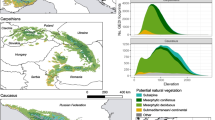Abstract
Strong winds are an important disturbance agent in northern Minnesota forests. On June 19, 1994, strong winds (>160 km h(-1)) associated with a tornado damaged forested areas within the Rydell National Wildlife Refuge, situated in Polk County Minnesota along the prairie-forest boundary. Field sampling was conducted immediately following the storm to quantify the type and extent of damage in four different community types, and to project future composition based on the nature of the storm damage and current understory characteristics, including the impact of overbrowsing by deer. Basal area in six sampled remnant forest stands was reduced by 33.5%, although the damage was heterogeneous; basal area in one stand was reduced by 68.1%. The overall effect of the storm was the removal of early- successional species (primarily Populus tremuloides) in larger size classes. Trees situated at stand edges were not more susceptible to snapping or uprooting than interior trees. Projections of future stand composition indicate that wind disturbance, unlike other agents of disturbance such as fire, may accelerate succession on the Refuge, such that early-successional stands will assume a later-successional character, while Acer-Tilia stands should maintain their late-successional character. Overbrowsing and preferential foraging by deer may significantly alter stand recovery patterns.
Similar content being viewed by others
References
Abrams, M. D., and Scott, M. L. 1989. Disturbance-mediated accelerated succession in two Michigan forest types. Forest Sci 35: 42–49.
Baker, D. G. 1983. Climate of Minnesota: Part XIV. Wind climatology and wind power. University of Minnesota Agricultural Experiment Station, Technical Bulletin AD-TB1955. St. Paul, Minnesota.
Bakuzis, E. V., and Hansen, H. L. 1959. A provisional assessment of species synecological requirements in Minnesota forests. Minnesota Forestry Notes 84, School of Forestry, University of Minnesota, St. Paul.
Brewer, R., and Merritt, P. G. 1978.Wind throw and tree replacement in a climax beech-maple forest. Oikos 30: 149–152.
Burns, R. M., and Honkala, B. H. 1990. Silvics of North America: 2. Hardwoods. Agricultural Handbook 654. U.S. Department of Agriculture, Forest Service, Washington D.C.
Canham, C. D., and Loucks, O. L. 1984. Catastrophic windthrow in the presettlement forests of Wisconsin. Ecol. 65: 803–809.
Daubenmire, R. F. 1936. The ‘Big Woods’ of Minnesota: its structure, and relation to climate, fire, and soils. Ecol. Monog. 6: 233–268.
Dunn, C. P., Guntenspergen, G. R., and Dorney, J. R. 1983. Catastrophic wind disturbance in an old-growth hemlock-hardwood forest, Wisconsin. Can. J. of Bot. 61: 211–217.
Forest Products Laboratory 1987. Wood Handbook: Wood as an Engineering Material. Agricultural Handbook 72, U.S. Department of Agriculture, Forest Service, Washington, D.C.
Foster, D. R. 1988. Species and stand response to catastrophic wind in central New England, U.S.A. J. of Ecol. 76: 135–151.
Frelich, L. E., and Lorimer, C.G. 1991. Natural disturbance regimes in hemlock-hardwood forests of the upper Great Lakes region. Ecol. Monog. 61: 145–164.
Glitzenstein, J. S., and Harcombe, P. A. 1988. Effects of the December 1983 tornado on forest vegetation of the Big Thicket, Southeast Texas, U.S.A. Forest Ecol. Management 25: 269–290.
Grimm, E. C. 1981. Chronology and dynamics of vegetation change in the prairie-woodland region of southern Minnesota, U.S.A. New Phytol. 93: 311–350.
Grizzle, J. E., Starmer, C. F., and Koch, G. G. 1969. Analysis of categorical data by linear models. Biometrics 25: 489–504.
Marschner, F. J. 1974. The original vegetation of Minnesota (map, 1:500 000 scale). U.S. Department ofAgriculture, Forest Service. North Central Forest Experiment Station, St. Paul. (Originally published in 1930.)
Matlack, G. R., Gleeson, S. K., and Good, R. E. 1993. Treefall in a mixed oak-pine coastal plain forest: immediate and historical causation. Ecol. 74: 1559–1566.
McAndrews, J. H. 1966. Postglacial history of prairie, savanna, and forest in northwestern Minnesota. Mem. Torrey Bot. Club 22: 1–72.
Minnesota Department of Natural Resources 1993. Minnesota's Native Vegetation: AKey toNatural Communities. Biological Report 20, Minnesota Department of Natural Resources, St. Paul.
Oliver, C. D., and Stevens, E. P. 1977. Reconstruction of a mixedspecies forest in central New England. Ecol. 58: 562–572.
Peterson, C. J., and Pickett, S. T. A. 1991. Treefall and resprouting following catastrophic windthrow in an old-growth hemlock-hardwoods forest. Forest Ecol. and Management 42: 205–217.
Putz, F. E., and Brokaw, N. V. L. 1989. Sprouting of broken trees on Barro Colorado Island, Panama. Ecol. 70: 508–512.
Ross, B. A., Bray, J. R., and Marshall, W. H. 1970. Effects of long-term deer exclusion on a Pinus resinosa forest in north-central Minnesota. Ecol. 51:1088–1093.
Runkle, J. R. 1990. Gap dynamics in an Ohio Acer-Fagus forest and speculations on the geography of disturbance. Can. J. of Forest Res. 20: 632–641.
SAS Institute. 1987. SAS Procedures Guide. SAS Institute, Cary North Carolina.
Sokal, R. R., and Rolf, F. J. 1981. Biometry. W. H. Freeman, San Francisco.
Stewart, L. O. 1935. Public Land Surveys: History, Instructions, Methods. Collegiate Press, Ames, IA.
Thom, H. C. S. 1963. Tornado probabilities. Monthly Wea. Rev. 91:730–736.
Upham, W. 1895. The Glacial Lake Agassiz. Monograph 25, U.S. Geological Survey, Washington, D.C.
Veblen, T. T., Hadley, K. S., Reid, M. S., and Rebertus, A. J. 1989. Blowdown and stand development in a Colorado subalpine forest. Can. J. of Forest Res. 19: 1218–1225.
Warde, W., and Petranka, J. W. 1981. A correction factor table for missing point-center quarter data. Ecol. 62: 491–494.
Webb, S. L. 1988.Windstorm damage and microsite colonization in two Minnesota forests. Can. J. of Forest Res. 18: 1186–1195.
Webb, S. L. 1989. Contrasting windstorm consequences in two forests, Itasca State Park, Minnesota. Ecol. 70: 1167–1180.
Winchell, N. H. 1884. Minnesota Geological and Natural History Survey, Final Report. 1: 278–279.
Author information
Authors and Affiliations
Rights and permissions
About this article
Cite this article
Dyer, J.M., Baird, P.R. Wind disturbance in remnant forest stands along the prairie-forest ecotone, Minnesota, USA. Plant Ecology 129, 121–134 (1997). https://doi.org/10.1023/A:1009761013081
Issue Date:
DOI: https://doi.org/10.1023/A:1009761013081




